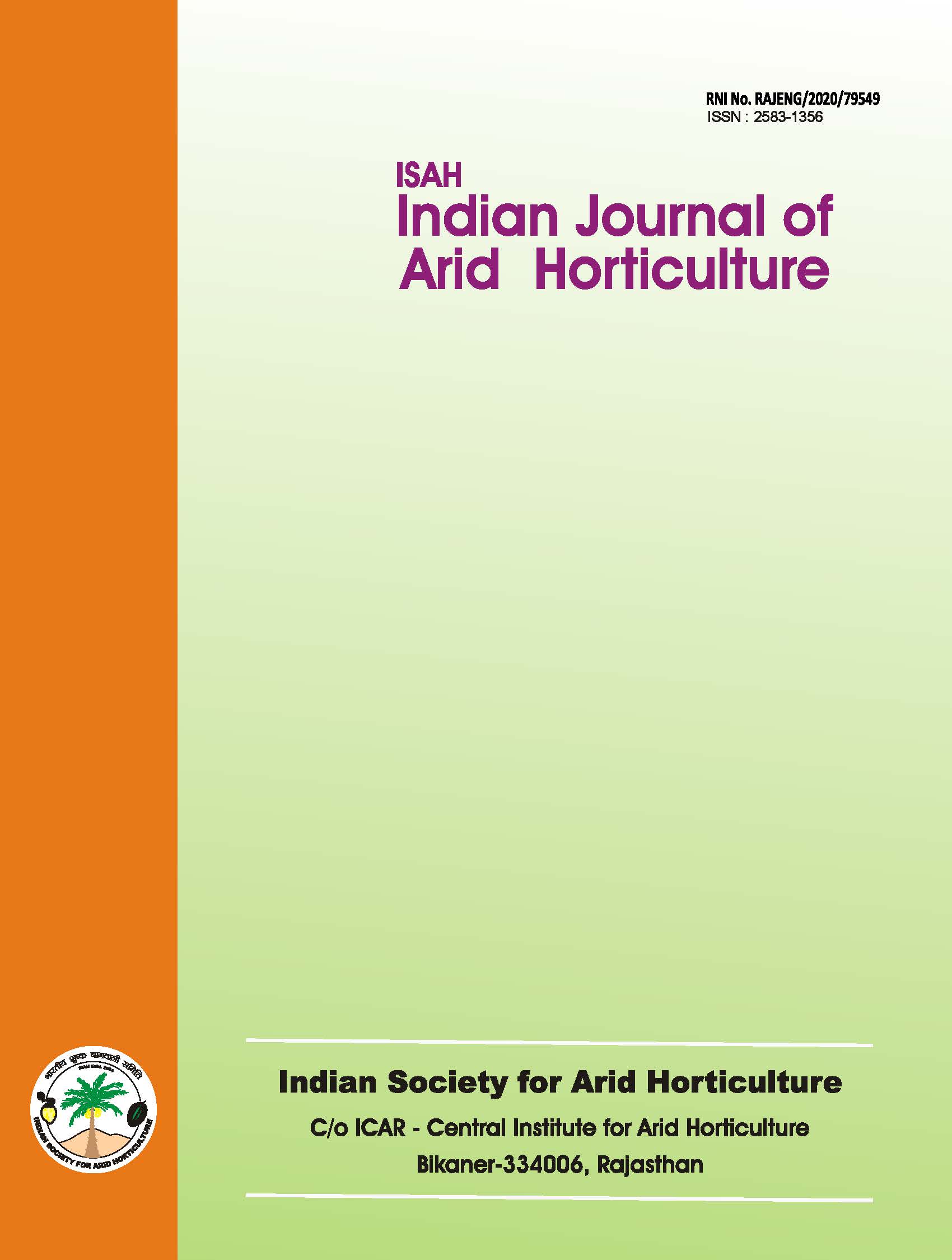Effect of saline water irrigation through drip method on yield of okra and salt build-up in sandy soil of western Rajasthan
Keywords:
Okra, Saline water, Drip irrigation, Salt build-upAbstract
Effect of saline water irrigation on Okra through drip system was evaluated on sandy soils having high hydraulic conductivity (7.2-7.9 cmh 1) and low moisture holding capacity (6.18 cm m'). Maximum yield of Okra (4.80 t/ha) was recorded at ECiw 3.0 dSm' with drip irrigation method. Irrigation with saline water 6.0 dSm' drastically decreased the yield (2.97 t/ha) and yield attributes of crop. Looking to the average yield of all three years under ECiw 0.25, 3.0 and 6.0 dSm treatments drip method was superior with 50.37% higher yield compared to flood irrigation method. The increasing levels of salinity of irrigation water increased the EC, of soil profile. The salinization pattern in soil with saline water irrigation under drip system showed that the zone of minimum salt accumulation existed just below the emitters. The salt concentration in soil profile increased with increase in lateral as well as vertical distance from the emitters. This is due to differences in moisture content of ponded, wetted and wetting zone of area irrigated by a particular emitter. The ponded zone had always higher moisture both laterally and vertically which started decreasing toward wetted zone with minimum at the end of wetting zone. This moisture variation caused movements of salts from the near vicinity of emitter, creating comparatively much less saline zone (ECe 1.30 dSm'with ECiw 6.0 dSm') in which root performed their activity providing better growing conditions. Salt concentration was highest (ECe 2.71) at 30 cm distance from emitter with saline water irrigation of ECiw 6.0 dSm'.Downloads
References
FAO. 1997. Small scale irrigation for Arid zones. Principles and Options, FAO, Development series 2, Food and Agriculture Organization of the United Nations, FAO, Rome, Italy. Pp. 51.
FAO. 2008. FAOSTAT Production, Food and Agriculture Organization of the United Nations (FAO), Rome.
Gopalan, C., Rama-Sastri, B. V., & Balasubramanian, S. C. 1989. Nutritive value of Indian foods, National Institute of Nutrition, ICMR, Hyderabad, India.
Kadam, J. R. and Kartikeyan, S. 2004. Yield and yield attributes of tomato as influenced by fertigation. In: Proceedings, National seminar on Development in Soil Science- 2004. Indian Soc. Soil Sci., pp 172.
Richards, L.A. 1954. Diagnosis and Improvement of saline alkali soils, U.S.D.A. Handbook No. 60.
Singh, S. D., Gupta, J. P., and Singh, P. 1978. Water requirement and saline water use by drip irrigation, Agron. J., 70: 948-951.
Singh, S. D. and Singh, P. 1978. Value of drip irrigation compared to conventional irrigation for vegetable production in hot arid climate, Agron. J., 70: 945-947.
Singh, R. B., Chauhan, C. P. S., and Shishodia, P. K. 2004. Comparative study of summer and winter season tomato crop tolerance to saline irrigation with drip method. In: Proceedings, National seminar on Development in Soil Science-2004, Indian Soc. Soil Sci., pp 170.
Tiwari, K. N., Mal, P. K., Singh, R. M., & Chattopadhyay. 1998a. Feasibility of drip irrigation under different soil covers in tomato, J. Agric. Eng., 35(2): 41-49.
Tiwari, K. N., Mal P. K., Singh, R. M., & Chattopadhyay. 1998b. Response of Okra (Abelmoschus esculentus L. Moench) to drip irrigation under mulch and non-mulch conditions, Agric. Water Management., 38: 91-102.
Tiwari, K. N., Singh, A., & Mal, P. K. 2003. Effect of drip irrigation on yield of cabbage (Brassica oleracea L. var. capitata) under mulch and non-mulch conditions, Agric. Water Management., 58: 19-28.

